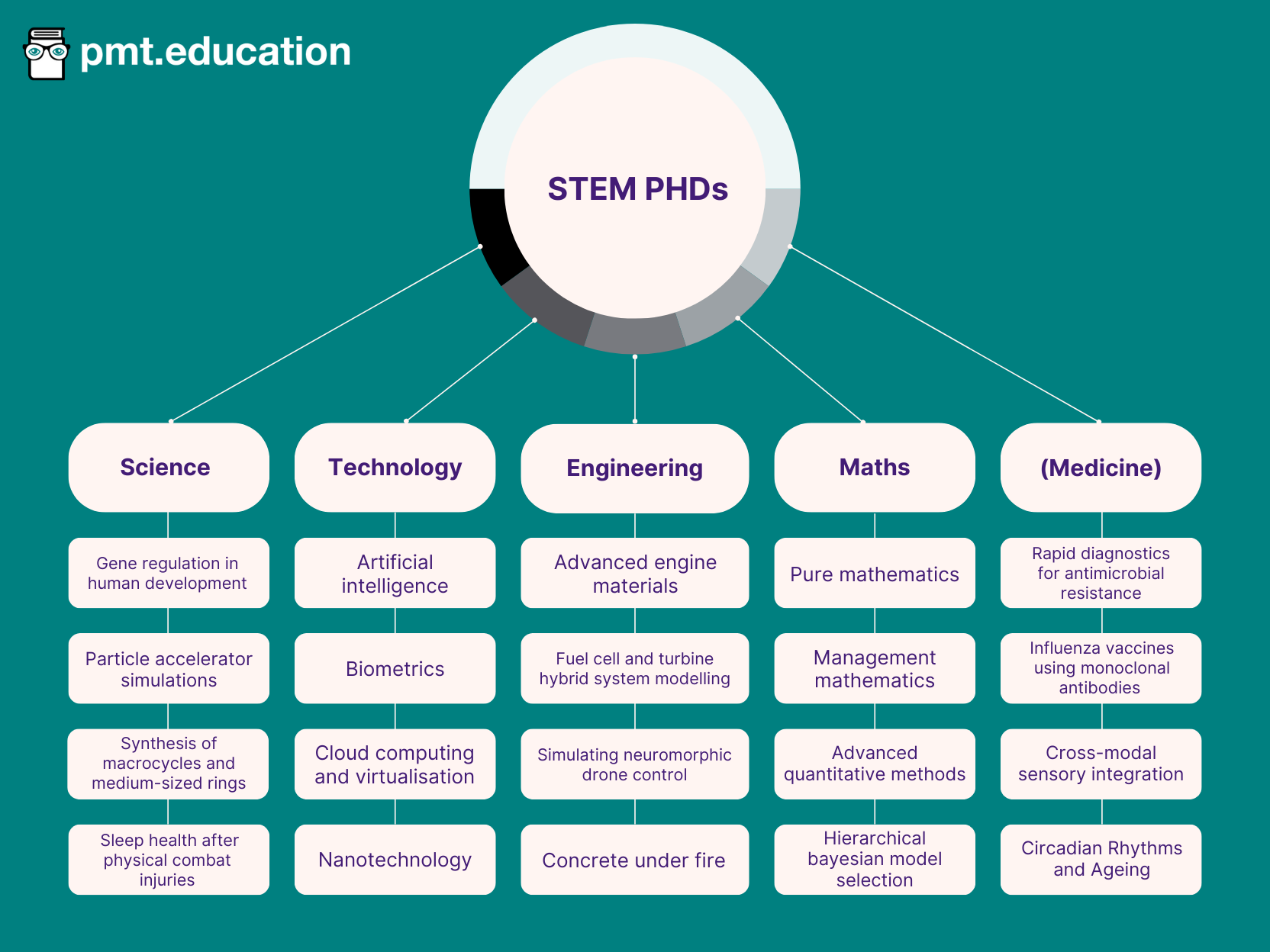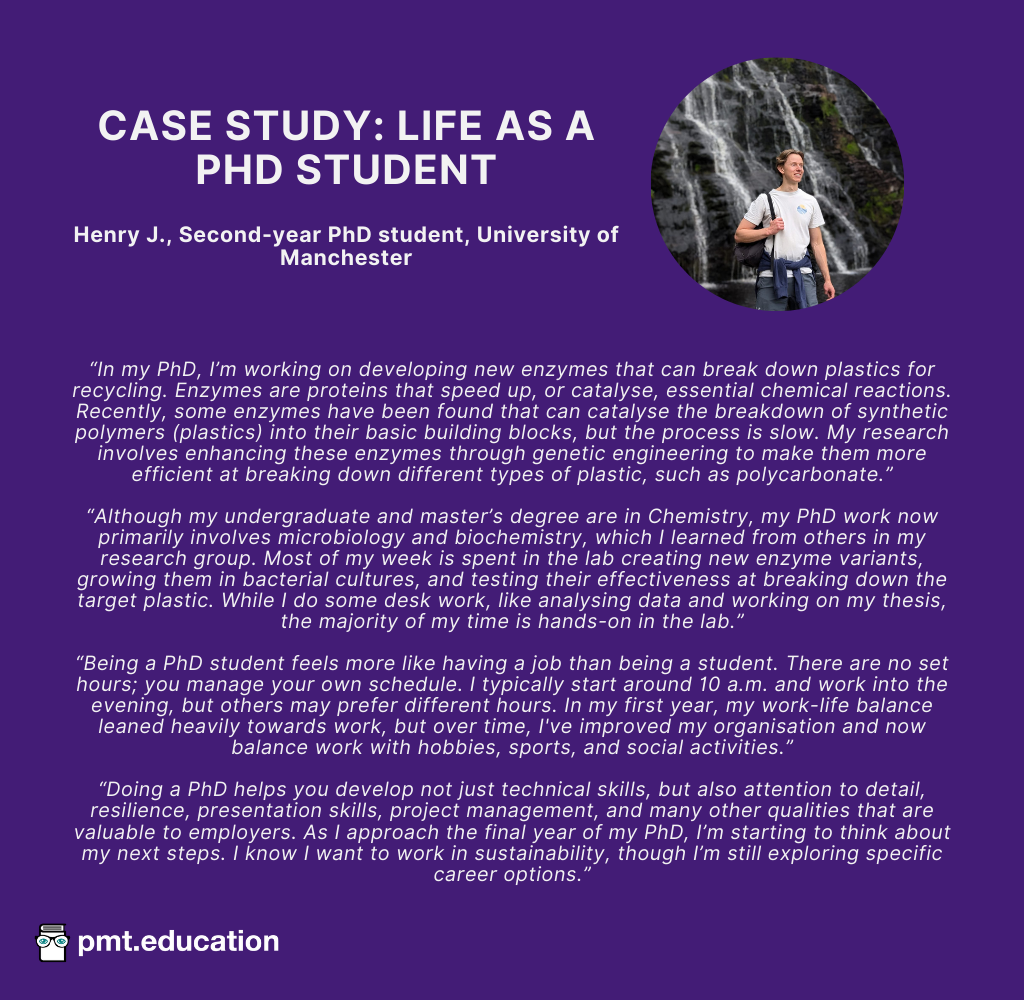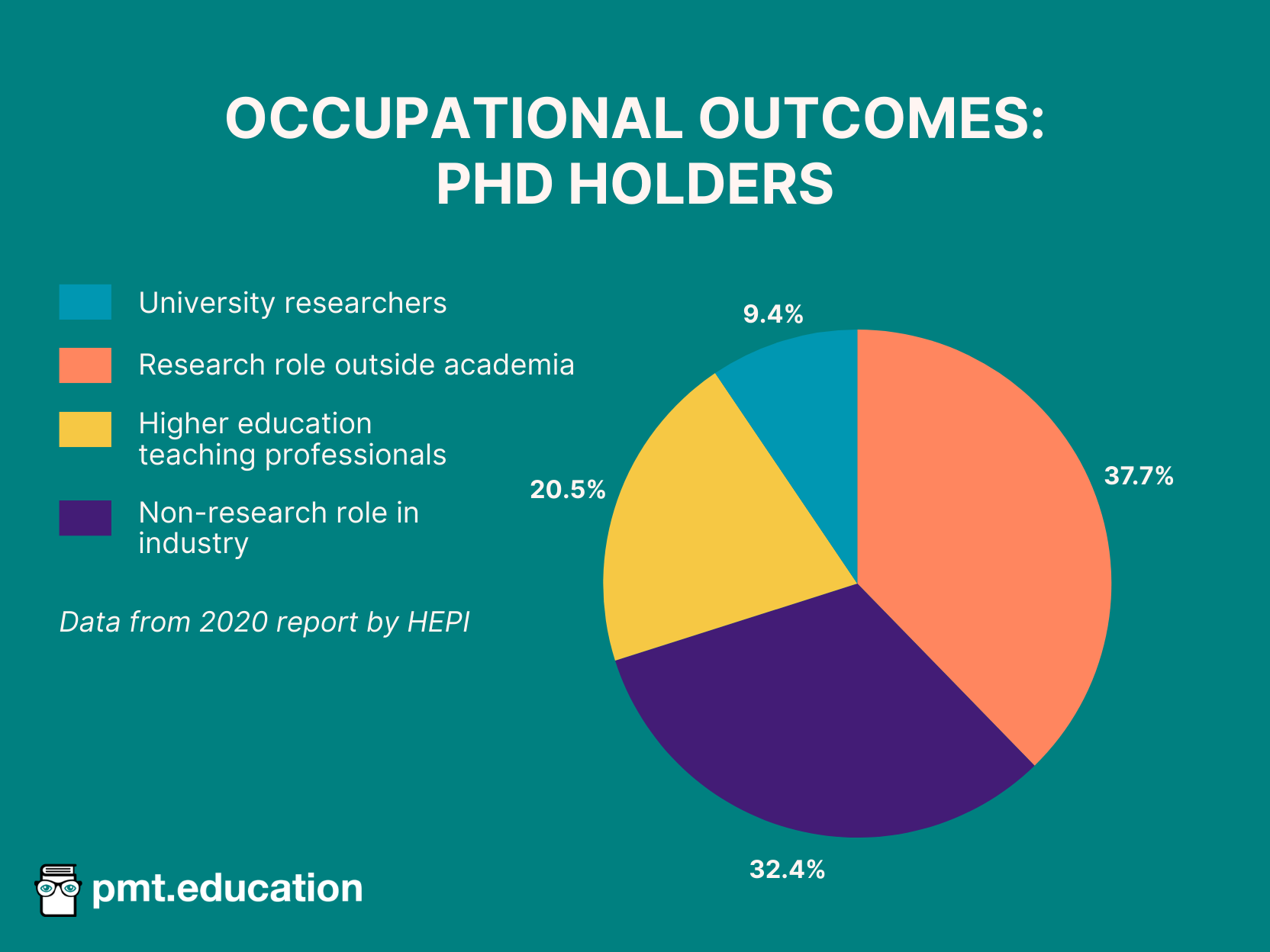Contents:
Qualification Level: Doctorate (Level 8)
Entry Requirements: Can vary: bachelor’s degree + professional experience, master’s degree, bachelor’s degree alone
Cost: Tuition fees, studentships (varies, some are funded, some aren’t)
Assessment Methods: Thesis + oral exam
Skills Developed: Advanced research skills, academic writing, subject expertise
Career Opportunities: Academic careers, research positions in industry
What is a PhD?
A PhD, or Doctor of Philosophy, is the highest level of academic degree offered by universities. Typically, it takes three to four years of full-time study or up to seven years part-time to complete. PhD programmes can be funded or self-funded, depending on the institution and specific programme. They involve conducting novel research in a specialised field and producing a thesis that contributes new insights to that field.
In this article, we will delve deeper into the various aspects of pursuing a PhD in STEM which can vary significantly from that for the arts and humanities. From understanding the application process and funding options to exploring life as a PhD student and career prospects post-graduation, this guide aims to provide a comprehensive overview for aspiring PhD candidates.
What are popular fields for STEM PhDs?
Below is an infographic featuring real STEM PhD titles to get an idea of the extent of specialisation and the diverse fields within STEM research. Remember, this is just a small sample – there are many more PhDs available for you to explore.

Before your PhD
What routes are there to a PhD?
When considering a PhD, there are several routes you can take, each with their own advantages and tailored to different academic and professional needs. Here’s an overview of the most common pathways to earning a PhD.
1. Master’s followed by PhD
One of the most traditional routes is to complete a master’s degree before applying for a PhD programme. A master’s degree typically lasts one to two years and can involve taught modules, research projects and dissertations. The key features of this route include:
- Choice and flexibility: Completing a full master’s degree first allows you to explore your research interests in depth and gain a clearer understanding of the field before pursuing independent research.
- Independent applications: This route offers the flexibility to attend different institutions and programmes for your bachelor’s, master’s and PhD. This can be advantageous if you want to work with specific researchers or access unique resources.
- Extended time frame: While it might take longer as you need to finish a full master’s programme before starting the PhD, it provides a solid foundation for your doctoral research.
2. Integrated master’s followed by PhD
An integrated master’s programme combines undergraduate and master’s studies into a single, continuous course, typically lasting four years. After completing this programme, you can then apply for a PhD. The key features of this route include:
- Streamlined pathway: You progress from undergraduate to master’s level without needing to apply for a separate master’s programme.
- Cohesive learning experience: The programme is designed to provide a seamless transition, ensuring the skills and knowledge gained in this combined undergraduate and postgraduate qualification prepare you for further education.
- Preparation for PhD: Completing an integrated master’s can give you a strong academic foundation, making you well-prepared for the demands of a PhD programme.

3. Integrated PhD
The Integrated PhD is a newer option that combines both master’s and PhD studies into a single, continuous programme, typically lasting around four years. You will earn a master’s qualification (MRes or MSc) in your first year and then you will work towards your PhD thesis from your 2nd year, making this route ideal for bachelor’s graduates without a master’s degree. The key features of this route include:
- Direct entry: You move directly from undergraduate studies into a PhD programme, eliminating the need to apply separately for a master’s and then a PhD.
- Consistency and continuity: The programme is structured to provide a natural learning progression, ensuring that the skills and knowledge gained during the initial phase directly support your PhD research.
- Time efficiency: Completing both degrees in a continuous programme can be more time-efficient compared to doing them separately, potentially reducing the total time spent in education.
Alternative names for the Integrated PhD include “New Route”, “4 year” and “1+3” programmes.
4. Direct entry from bachelor’s degree to PhD
Although less common and often dependent on the institution and the candidate’s academic achievements, pursuing a PhD directly after a bachelor’s degree can be a viable option. In fact, STEM PhDs are typically less likely to require a master’s degree compared to those in arts and humanities. It is always worth confirming entry requirements with individual institutions. Additionally, even if a master’s degree is not a requirement, many PhD programmes view applicants with a master’s favourably. The key features of this route are:
- Accelerated route: This option allows highly capable students to bypass the master’s stage and proceed directly to doctoral research.
- High standards: Direct entry often requires a strong academic record, research experience, and a clear demonstration of your readiness for advanced research.
- Intensive programme: The transition can be challenging as you move directly into a rigorous research environment without the intermediate step of a Master’s programme.

Which PhD route should you choose?
The best path to a PhD depends on your personal and professional goals, as well as your current stage in your academic journey:
- Master’s followed by PhD: Ideal if you want to take time to develop your research interests and prefer flexibility in choosing institutions.
- Integrated master’s and PhD: Suitable if you want a structured yet flexible route with the option to adapt your focus as you progress.
- Integrated PhD: Perfect for those who are certain about their research path and want a streamlined, time-efficient route directly from undergraduate study.
- Direct entry from bachelor’s degree to PhD: Best for exceptional students ready to dive into doctoral research without the intermediate step of a master’s degree.
What types of PhD are there?
While the traditional PhD by thesis is the most common route, involving original research and a detailed thesis, there are other doctorate options available that might be more suitable depending on your career stage and goals.
A Doctorate by Publication could be an excellent choice for mid-career academics. This route involves submitting a collection of 5-8 published papers, ideal for those who have already made significant contributions to their field.
Professional doctorates, such as the Doctor of Business Administration (DBA), Doctor of Education (EdD), Engineering Doctorate (EngD), and Doctor of Medicine (MD), are designed for professionals looking to integrate academic research with their ongoing work. These programmes often involve part-time study and focus on applying research to real-world issues, making a direct impact on their field.
Can you do a STEM PhD online?
Yes, there are some STEM PhDs you can complete online, although some may still require some in-person attendance for lab work and other practical components. Online STEM PhD programmes should offer the same academic rigour and research opportunities as traditional on-campus programmes while providing the flexibility to study from anywhere.
While online programmes offer convenience and accessibility to various specialisations, success requires strong self-discipline and time management skills. Ensure the institution is accredited and can support your research needs to maximise the benefits of an online PhD.
Where can you find STEM PhD opportunities?
When applying for a STEM PhD in the UK, you typically have two main options: applying to advertised opportunities or approaching universities with your own PhD title.
Advertised opportunities will come with specific research goals and resources already in place. This is the more common route for STEM students and provides a structured path with guidance from established supervisors.
Alternatively, by approaching universities, you can propose your own PhD research project where you develop a unique research title and plan that is then approved by a potential supervisor and the university. This option allows for more independence and the chance to pursue a specific area of interest, but requires you to clearly outline your research objectives and demonstrate the feasibility of your project. This can be challenging.
For those looking to find existing PhD programmes rather than writing a research proposal, several resources can help you locate opportunities that fit your research interests and career goals. Online databases are an excellent starting point for finding PhD opportunities. Notable platforms include:
- FindAPhD: A predominantly UK-based database featuring a wide range of PhD projects across various disciplines.
- DiscoverPhDs: Offers detailed listings of STEM PhD opportunities mainly across the UK but also in Europe, including funding information and programme details.
- PhDportal: Provides information on PhD programmes from universities around the world, allowing you to search by country, field of study, and university.
- EURAXESS: Focuses on research opportunities in Europe, including PhD positions, research fellowships, and funding schemes for researchers.
- Jobs.ac.uk: While primarily a job board for academia, it also lists numerous PhD and doctoral research positions across the UK.

Many universities also have dedicated sections on their websites for PhD opportunities and studentships. These pages often list available programmes, funding options, and application requirements specific to each institution. Checking individual university web pages can provide detailed information about specific research areas and potential supervisors.
Major research centres and institutes are also excellent places to find PhD opportunities. For example, institutions like CERN and the NIHR (National Institute for Health and Care Research) offer doctoral programmes in cutting-edge STEM fields. Research centres often have their own application processes and may offer unique opportunities not found in traditional university settings.
By exploring these resources, you can discover a variety of PhD opportunities that align with your research interests and academic aspirations.
What are the entry requirements for a PhD?
To pursue a PhD, you typically need at least a bachelor’s degree with at least an Upper Second-Class honours (2:1). While some programmes accept students directly from undergraduate studies, many prefer or sometimes even require candidates to hold a master’s degree with Merit or Distinction.
Language proficiency is another crucial entry requirement, especially for international students. Proficiency in English is often assessed through exams such as TOEFL or IELTS. Achieving the required scores in these exams ensures you can effectively communicate your research and integrate into the academic community.
For self-funded PhDs where you propose your own thesis idea rather than applying for predefined research projects, the application process typically involves submitting a detailed research proposal. Additionally, all PhD applicants, regardless of the programme, usually must write an academic CV, attend an interview and submit two or three academic references to support the application. Some programmes may also require graduate entry tests, although this is less common.
5 top tips for writing your STEM PhD proposal
For STEM students, it is more common to apply to existing predefined research projects at a university, which do not require a proposal. However, for those wishing to propose their own research, writing a compelling PhD proposal is an important step in securing a place in a doctoral programme. Here are some top tips to help you create a strong proposal:
1. Be clear, concise and original
Clearly state what you wish to research and highlight how your research is new and unique. A straightforward and novel proposal helps communicate your ideas effectively and differentiates your work from others.
2. Use an easy-to-understand title
Create a title that clearly and simply states the focus of your proposed PhD research. An understandable title helps readers quickly grasp the essence of your proposal.
3. Provide an overview and methodology
Give a comprehensive overview of your research idea, including key scientific details, but avoid presenting extensive findings. Detail your proposed methods, both practical and theoretical, showing you have a well-thought-out plan for conducting your research.
4. Highlight research contributions
Clearly articulate how your research will contribute to the field and demonstrate your awareness of existing research. Include a literature review that shows how your work will expand upon current knowledge and discuss potential outcomes and implications.
5. Be feasible and professional
Ensure your research is feasible within the resources and timeframe of the university you are applying to. Present your proposal in a professional manner with numbered pages, a contents page, and thorough proofreading. Seek a second opinion, preferably from an academic, to catch any errors or areas needing improvement.
During your PhD
What is life like as a STEM PhD student?
Life as a STEM PhD student can be highly varied depending on your research focus and programme structure. Some PhD programmes include taught components, such as lectures, seminars, or training sessions that complement your research. However, many are more research-intensive, involving significant lab work, fieldwork, or computational tasks.
Your daily life will also differ depending on the stage of your PhD. In the first year, you typically spend considerable time understanding your research area and laying the groundwork for your project. The second year often involves diving into the bulk of your research, alongside taking on teaching or lab supervision roles, which are often part of your university support responsibilities listed in your funding arrangement. In the final years, your focus will shift to writing up your research, preparing your thesis, and preparing for your PhD viva (oral examination).
You generally have the freedom to choose your working hours, provided they total 35 hours per week. While some students opt for a traditional 9–to–5 schedule, others might be more productive early in the morning or late in the evening. However, the nature of research can sometimes lead to longer hours, including weekends and evenings, especially as deadlines approach or when crucial experiments or data analysis is underway. Part-time PhD students usually commit to about 17.5 hours per week.
Beyond research and university roles, PhD students often engage in activities such as attending conferences, publishing papers, and collaborating with other researchers. Balancing these with personal commitments can be challenging, but it also provides opportunities for professional growth and networking.

What holidays do you get as a PhD student?
As a PhD student, you are typically entitled to between 25 and 30 days of annual leave, plus public holidays, depending on your institution. Unlike undergraduate or taught postgraduate programmes, there is no dedicated summer holiday. Your leave should be planned around your research deadlines and lab schedules, and you should always check your institution’s specific policies for detailed information.
How are PhDs assessed?
The assessment of a PhD involves two key components: the thesis and the viva (oral examination).
Thesis: During the final years of your PhD, you will write a thesis, which is a comprehensive document summarising your research project. This document outlines the aims, methodologies, and outcomes of your research. In STEM fields, your thesis will often focus on discussing experiments, data, and findings in detail. The length of the thesis can vary by institution, but it typically spans around 80,000 words. This extensive work represents the culmination of your research efforts and demonstrates your ability to conduct and present high-quality, original research.
Viva: After submitting your thesis, you will undergo a viva, or oral examination, where you defend your research findings. This examination involves discussing your thesis with a panel of experts who will assess your understanding of the research, its significance, and its contribution to the field.
Your PhD is usually awarded a pass or fail. The criteria for passing generally include the quality of your thesis, your performance in the viva, and the overall originality and significance of your research project. These assessments together ensure that you have developed the necessary skills and have made a meaningful contribution to your field of study.

How much does a PhD cost in 2024/2025 (UK)?
In the UK, PhD tuition fees can vary between courses, with many universities charging £4,786 for the 2024/25 academic year. These fees are set by UK Research and Innovation (UKRI) for UK students. International students, however, usually face higher fees, often reaching £20,000 per year. STEM PhDs are typically more expensive due to the specialised equipment and resources required.
Remember that tuition fees do not include other expenses such as living costs, travel, and personal expenditures, which should also be factored into your financial planning. These expenses are often the biggest challenge, as PhD fees are relatively low compared to other degrees. While these costs might seem daunting, you may not need to cover them all yourself; there is potential funding available to help with these costs.
How to get funding for a PhD
For many STEM PhD programmes, especially those with predefined research projects, funding is arranged by the university, so if you are accepted, you may automatically be eligible for this support. If you are proposing your research title, you may be responsible for securing funding yourself. There are several options available that can help cover tuition fees and living expenses, so you might not need to bear these costs entirely on your own. Here are some key funding options available:
Studentships
Studentships can provide significant financial support and may be either partially funded (covering only tuition fees) or fully funded (including both tuition fees and a stipend for living costs). You can find studentships through various sources such as government bodies like UK Research and Innovation (UKRI), universities, charities and trusts (e.g., for medical research), and businesses. Always read the terms of these funding organisations carefully; for example, businesses may require you to work for them upon PhD graduation.
Doctoral loans
UK students can apply for doctoral loans through Student Finance England. For the 2024/2025 academic year, you can borrow up to £29,390. This loan is not means-tested, meaning it is available to all eligible students regardless of financial circumstances. It can help cover both tuition fees and living costs. This is often an important option for self-funded students.
Graduate teaching assistantships
Graduate teaching assistantships offer another funding option. These positions involve teaching undergraduates and may include conducting tutorials, demonstrating labs, or marking papers. The income from these roles varies depending on the number of hours worked and the specifics of the assistantship. Besides financial support, these positions provide valuable teaching experience.
Part-time PhD
Lastly, considering a part-time PhD while working can help manage costs. This option allows you to earn an income and spread out your research over a longer period, potentially easing financial pressures and offering practical work experience.
Scholarships, grants, and bursaries
In addition to the above options, scholarships, bursaries, and grants can provide further financial support. These are often awarded based on academic merit, financial need, or specific research interests. For more information on these types of funding and how to apply, refer to our dedicated article on STEM scholarships, grants and bursaries.
After your PhD
Outcomes of PhD holders
More than 80% of those who completed doctorate research go directly into employment, according to the 2021-22 Graduate Outcomes survey by HESA. This highlights that a PhD provides a solid foundation for diverse career trajectories.
PhD holders in employment take up both research and non-research roles in various settings. Below is a pie chart showing the different occupational outcomes of PhD graduates according to a 2020 HEPI report:

Perhaps surprisingly, university researchers form the smallest fraction of PhD graduates. The majority enter roles in industry, with many taking up positions in research outside of academia. Additionally, a significant number pursue teaching roles in higher education. This variety in career outcomes demonstrates the wide-ranging opportunities available to PhD graduates.
The same HEPI report details that STEM graduates are significantly more likely to undertake research outside of academia compared to their humanities and arts counterparts. Specifically, graduates in biological sciences are over 40% more likely to pursue research roles outside of academia than those in arts and humanities. Additionally, a high proportion of graduates in biomedical sciences, physical sciences, and engineering enter research roles outside of academia (approximately 60%).
Is a PhD worth it?
Whether a PhD is worth pursuing depends on your career goals, financial situation, and personal interests. For individuals passionate about research and aiming for specialised roles in academia or industry, a PhD can be highly valuable. It offers the chance to become an expert in a specific field and can be an essential for those seeking advanced research positions or academic careers.
Financially, pursuing a PhD requires a significant investment, and while funding options are available, they may not cover all costs. This means potentially facing several years of limited income and delayed financial returns. Thus, it’s important to consider the extent of the long-term career benefits.
Additionally, a PhD provides valuable skills such as critical thinking and project management, which are applicable across various sectors. Even if an academic career isn’t the end goal, these skills can enhance employability and open doors in many professional fields.
In summary, a PhD can be ideal for those committed to deepening their expertise and pursuing research or academic roles. Weighing the potential benefits against the costs and considering your career aspirations will help determine if a PhD aligns with your long-term goals.
Top 5 tips for PhD applicants
Henry, a second-year PhD student at the University of Manchester, has compiled these tips for those aspiring to undertake a STEM PhD.
- Find the right fit: The success of your PhD depends on your choice of supervisor, research group, and project, along with the city and university you select, so be sure to do thorough research before applying.
- Talk to current students: Speak candidly with those already in the research group to understand their experiences and get a true sense of what it’s like.
- Choose a project you’ll love: Pick a project you’re passionate about or at least interested in – this will help you stay motivated during tough times.
- Prepare for challenges: PhDs are challenging and don’t always go to plan. Resilience and adaptability are key to getting through it.
- Embrace the learning process: Imposter syndrome is common, but it’s important to remember that the PhD journey is a learning process. You’ll develop the skills you need over time, even if you feel out of your depth at the start.
FAQs
What does PhD stand for?
PhD stands for Doctor of Philosophy. It is an advanced academic degree awarded to individuals who have completed substantial research in a specific field of study.
DPhil vs PhD: What is the difference?
The terms DPhil and PhD are used interchangeably. The main difference lies in the terminology used by different institutions. For example, the University of Oxford awards a DPhil, while most other universities use the term PhD. Despite the different names, both degrees represent the same level of academic achievement and involve completing original research.
Is PhD the highest degree?
Yes, a PhD is generally considered the highest academic degree available. It signifies that you have contributed original knowledge to your field.
Can you do a PhD without a master’s degree?
In many cases, it is possible to pursue a PhD without having completed a master’s degree. Some PhD programmes accept candidates with a strong undergraduate background or relevant experience. It is always worth confirming entry requirements with individual institutions. Note: many PhD programmes view applicants with a master’s degree favourably, even though it may not be a strict requirement.
How long is a PhD?
The duration of a PhD can vary depending on the programme and your studying pace. Generally, a full-time PhD takes between 3–4 years to complete, while part-time PhDs can take up to 7 years.
Can you take a gap year before your PhD?
Yes, you can take a gap year before starting a PhD. Many students use this time to gain work experience, earn money, or clarify their research interests. Just inform your PhD programme about your plans and follow their deferral process if needed.

Comments